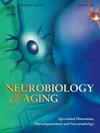词汇生成中白质结构的中年动态变化
IF 3.5
3区 医学
Q2 GERIATRICS & GERONTOLOGY
引用次数: 0
摘要
我们的目的是研究从中年开始随着命名潜伏期的延长而出现的与词汇生成困难相关的白质变化。为了延缓词汇生成能力的衰退,中年人可能会依赖 LARA 模型(老龄词汇存取和检索)提出的领域通用和语言特异性补偿机制。然而,支持这些机制的白质变化在很大程度上仍不为人所知。利用 CAMCAN 队列的数据,我们采用了一种无监督和数据驱动的方法来研究扩散加权成像与词汇生成之间的关系。我们的研究结果表明,中年时期分布在背侧、腹侧和前部皮质-皮质下网络中的大脑结构发生了变化,这标志着词汇生成能力在 53-54 岁左右开始下降。中年人最初可能会采用 "语义策略 "来弥补词汇生成方面的挑战,但随着语义控制能力的下降,这种策略似乎会在后期(55-60 岁)受到影响。这些见解强调了在健康老龄化过程中词汇生成能力的轨迹中领域一般过程和语言特异过程之间的相互作用,并暗示了与语言相关的神经退行性病变的潜在生物标记物。本文章由计算机程序翻译,如有差异,请以英文原文为准。
Midlife dynamics of white matter architecture in lexical production
We aimed to examine the white matter changes associated with lexical production difficulties, beginning in midlife with increased naming latencies. To delay lexical production decline, middle-aged adults may rely on domain-general and language-specific compensatory mechanisms proposed by the LARA model (Lexical Access and Retrieval in Aging). However, the white matter changes supporting these mechanisms remains largely unknown. Using data from the CAMCAN cohort, we employed an unsupervised and data-driven methodology to examine the relationships between diffusion-weighted imaging and lexical production. Our findings indicate that midlife is marked by alterations in brain structure within distributed dorsal, ventral, and anterior cortico-subcortical networks, marking the onset of lexical production decline around ages 53–54. Middle-aged adults may initially adopt a “semantic strategy” to compensate for lexical production challenges, but this strategy seems compromised later (ages 55–60) as semantic control declines. These insights underscore the interplay between domain-general and language-specific processes in the trajectory of lexical production performance in healthy aging and hint at potential biomarkers for language-related neurodegenerative pathologies.
求助全文
通过发布文献求助,成功后即可免费获取论文全文。
去求助
来源期刊

Neurobiology of Aging
医学-老年医学
CiteScore
8.40
自引率
2.40%
发文量
225
审稿时长
67 days
期刊介绍:
Neurobiology of Aging publishes the results of studies in behavior, biochemistry, cell biology, endocrinology, molecular biology, morphology, neurology, neuropathology, pharmacology, physiology and protein chemistry in which the primary emphasis involves mechanisms of nervous system changes with age or diseases associated with age. Reviews and primary research articles are included, occasionally accompanied by open peer commentary. Letters to the Editor and brief communications are also acceptable. Brief reports of highly time-sensitive material are usually treated as rapid communications in which case editorial review is completed within six weeks and publication scheduled for the next available issue.
 求助内容:
求助内容: 应助结果提醒方式:
应助结果提醒方式:


